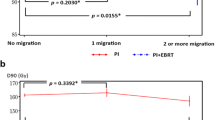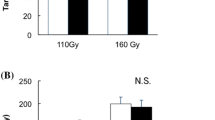Abstract
Introduction
The aim of our study was to review seed loss and its impact on dosimetry as well as the influence of the treating physician on seed loss and dosimetry in patients treated with prostate brachytherapy using permanent loose 125I implant.
Patients and methods
We analyzed 1087 consecutive patients treated by two physicians between July 2005 and April 2015 at a single institution. Pelvic fluoroscopic imaging was done 30 days post implant and a chest X-ray when seed loss was observed.
Results
Seed loss occurred in 19.4 % of patients: in 20.0 % of implants done by the most experienced physician and in 17.2 % by the less experienced physician (p = 0.4) and migration to the thorax occurred in 5.9 % (6.9 vs. 2.2 %, p = 0.004). The mean seed loss rate was 0.57 % [standard deviation (SD) 1.39] and the mean rate of seeds in the thorax was 0.14 % (SD 0.65). The most experienced physician had a higher mean number of seeds lost: 0.36 versus 0.25 (p = 0.055), and a higher mean number of seed migration to the thorax: 0.1 versus 0.02 (p < 0.001). When at least one seed was lost, a decrease of 4.2 Gy (p < 0.001) in the D90 and a decrease of 3.5 % (p = 0.002) in the V150 was observed.
Conclusion
We found a significant decrease in V150 and D90 with the occurrence of seed loss. Furthermore, we found a difference in seed migration among the physicians demonstrating that seed loss is operator dependant.
Zusammenfassung
Zielsetzung
Wir analysierten den Prozentsatz des Seed-Verlusts sowie den Einfluss von Arzterfahrung und Seed-Abgang auf die Dosimetrie bei Patienten, die mit einer Prostata-Brachytherapie mit permanent beweglichen 125I-Implantaten behandelt wurden.
Patienten und Methode
Eingeschlossen in diese Studie wurden alle zwischen Juli 2005 und April 2015 an unserem Krankenhaus von zwei Ärzten konsekutiv behandelten 1087 Patienten. Anhand fluoroskopischer Bilder wurden noch vorhandene Seeds 30 Tage nach dem Eingriff gezählt. Bei unvollständiger Seed-Anzahl wurde ein Thorax-Röntgenbild angefertigt.
Ergebnisse
In 19% der Patienten ging mindestens ein Seed verloren: 20% der Implantate beim erfahrenen Arzt und 17,2 % beim weniger erfahrenen Arzt (p = 0,4). Eine Migration zum Thorax wurde in 5,9% nachgewiesen (6,9 vs. 2,2 %; p = 0,004). Die durchschnittliche Seed-Verlustrate war 0,57% [Standardabweichung (SD) 1,39] und der Prozentsatz an abgegangenen Seeds pro implantierten Seeds 0,14% (SD 0,65). Der erfahrenere Arzt hatte im Vergleich zum weniger erfahrenen Arzt einen höheren Prozentsatz abgegangener Seeds (0,36% vs. 0,25%; p = 0,055) sowie von Seeds im Thorax (0,1% vs. 0,02%; p < 0,001). Beim Verlust von mindestens einem Seed wurde eine Reduktion der D90 um 4,2 Gy (p < 0,001) und der V150 um 3,5% (p = 0,002) festgestellt.
Schlussfolgerung
Ein Seed-Abgang senkt V150 und D90 signifikant. Ob ein Seed-Abgang nachgewiesen werden kann, hängt vom behandelnden Arzt ab.


Similar content being viewed by others
References
Sugawara A, Nakashima J, Kunieda E, Nagata H, Mizuno R, Seki S et al (2011) Incidence of seed migration to the chest, abdomen, and pelvis after transperineal interstitial prostate brachytherapy with loose (125)I seeds. Radiat Oncol 6:130
Kono Y, Kubota K, Aruga T, Ishibashi A, Morooka M, Ito K et al (2010) Swelling of the prostate gland by permanent brachytherapy may affect seed migration. Jpn J Clin Oncol 40:1159–1165
Zhu AX, Wallner KE, Frivold GP, Ferry D, Jutzy KR, Foster GP (2006) Prostate brachytherapy seed migration to the right coronary artery associated with an acute myocardial infarction. Brachytherapy 5:262–265
Chen WC, Katcher J, Nunez C, Tirgan AM, Ellis RJ (2012) Radioactive seed migration after transperineal interstitial prostate brachytherapy and associated development of small-cell lung cancer. Brachytherapy 11:354–358
Knaup C, Mavroidis P, Esquivel C, Stathakis S, Swanson G, Baltas D et al (2012) Investigating the dosimetric and tumor control consequences of prostate seed loss and migration. Med Phys 39:3291–3298
Beaulieu L, Archambault L, Aubin S, Oral E, Taschereau R, Pouliot J (2004) The robustness of dose distributions to displacement and migration of 125I permanent seed implants over a wide range of seed number, activity, and designs. Int J Radiat Oncol Biol Phys 58:1298–308
Gao M, Wang JZ, Nag S, Gupta N (2007) Effects of seed migration on post-implant dosimetry of prostate brachytherapy. Med Phys 34:471–480
Kunos CA, Resnick MI, Kinsella TJ, Ellis RJ (2004) Migration of implanted free radioactive seeds for adenocarcinoma of the prostate using a Mick applicator. Brachytherapy 3:71–77
Tapen EM, Blasko JC, Grimm PD, Ragde H, Luse R, Clifford S et al (1998) Reduction of radioactive seed embolization to the lung following prostate brachytherapy. Int J Radiat Oncol Biol Phys 42:1063–1067
Fuller DB, Koziol JA, Feng AC (2004) Prostate brachytherapy seed migration and dosimetry: analysis of stranded sources and other potential predictive factors. Brachytherapy 3:10–19
Hathout L, Donath D, Moumdjian C, Tetreault-Laflamme A, Larouche R, Beliveau-Nadeau D et al (2011) Analysis of seed loss and pulmonary seed migration in patients treated with virtual needle guidance and robotic seed delivery. Am J Clin Oncol 34:449–453
Taussky D, Moumdjian C, Larouche R, Beliveau-Nadeau D, Boudreau C, Hervieux Y et al (2012) Seed migration in prostate brachytherapy depends on experience and technique. Brachytherapy 11:452–456
Bowes D, Gaztanaga M, Araujo C, Kim D, Parker B, Batchelar D et al (2013) A randomized trial comparing seed displacement of coated seeds to regular loose seeds at 30 days postimplant. Brachytherapy 12:362–367
Ishiyama H, Satoh T, Kawakami S, Tsumura H, Komori S, Tabata K et al (2014) A prospective quasi-randomized comparison of intraoperatively built custom-linked seeds versus loose seeds for prostate brachytherapy. Int J Radiat Oncol Biol Phys 90:134–9
Zuber S, Weiss S, Baaske D, Schope M, Stevens S, Bodis S et al (2015) Iodine-125 seed brachytherapy for early stage prostate cancer: a single-institution review. Radiat Oncol 10:49
Rosenthal SA, Bittner NH, Beyer DC, Demanes DJ, Goldsmith BJ, Horwitz EM et al (2011) American Society for Radiation Oncology (ASTRO) and American College of Radiology (ACR) practice guideline for the transperineal permanent brachytherapy of prostate cancer. Int J Radiat Oncol Biol Phys 79:335–41
Shiraishi Y, Yorozu A, Ohashi T, Toya K, Saito S, Nishiyama T et al (2014) A dose-response analysis of biochemical control outcomes after (125)I monotherapy for patients with favorable-risk prostate cancer. Int J Radiat Oncol Biol Phys 90:1069–75
Gacci M, Serni S, Lapini A, Vittori G, Vignolini G, Nesi G et al (2008) PSA recurrence after brachytherapy for seed misplacement: a double-blind radiologic and pathologic work-up after salvage prostatectomy. Prostate Cancer Prostatic Dis 11:99–101
Nag S, Demanes DJ, Hagan M, Rivard MJ, Thomadsen BR, Welsh JS et al (2011) Definition of medical event is to be based on the total source strength for evaluation of permanent prostate brachytherapy: a report from the American Society for Radiation Oncology. Pract Radiat Oncol 1:218–223
Acknowledgments
We thank David Roberge, MD for his helpful suggestions in preparing this article.
Author information
Authors and Affiliations
Corresponding author
Ethics declarations
Conflicts of interest
N. El-Bared, N. Sebbag, D. Béliveau-Nadeau, Y. Hervieux, R. Larouche, and G Delouya state that there are no conflicts of interest. D. Taussky receives an educational grant from Elekta. The department of radiation oncology of the Université de Montréal receives support for a brachytherapy fellowship. We did not receive any direct financial support to conduct this research.
This study was approved by the institutional ethics committee, therefore the study has been performed in accordance with the ethical standards laid down in the 1964.
Rights and permissions
About this article
Cite this article
El-Bared, N., Sebbag, N., Béliveau-Nadeau, D. et al. Seed loss in prostate brachytherapy. Strahlenther Onkol 192, 305–311 (2016). https://doi.org/10.1007/s00066-016-0961-4
Received:
Accepted:
Published:
Issue Date:
DOI: https://doi.org/10.1007/s00066-016-0961-4




